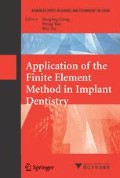Abstract
The finite element method may be applied to all kinds of materials in many kinds of situations: solids, fluids, gases, and combinations thereof; static or dynamic, and, elastic, inelastic, or plastic behaviour. In this book, however, we shall restrict the treatment to the deformation and stress analysis of solids, with particular reference to dental implants.
Access this chapter
Tax calculation will be finalised at checkout
Purchases are for personal use only
Preview
Unable to display preview. Download preview PDF.
References
Argyris JH (1995) Energy Theorems and Structural Analysis. Aircraft Engineering 27
Bendixen A (1914) Die Methode der Alpha Gleichungen zur Bererchnung von Rahmenkonstruktionen, Berlin
Castigliano A (1875) Nuova Teoria Intorno dell Equilibrio dei Sistemi Elastici. Atti Acc Sci Torino
Clapeyron (1857) Theorem of Three Moments. Comptes Rendus 45:1076
Clough RW (1960) The Finite Element Method in Plane Stress Analysis. J Struc Div, ASCE, Proc. 2nd Conf. on Electronic Computation 345–378
Cook RD, Malcus DS, Plesha ME (1989) Concepts and Applications of Finite Element Analysis, Third Ed. New York, USA: John Wiley & Sons
Corum JM, N Krishnamurthy (1969) A Three-dimensional Finite Element Analysis of a Prestressed Concrete Reactor Vessel Model, Proc. of Symposium on Application of Finite Element Methods in Civil Engineering. Vanderbilt University, Nashville, Tennessee, USA 63–94
Courant R (1943) Variational Methods for the Solution of Problems of Equilibrium and Vibration. Bull Am Math Soc 49:1–23
Cross H (1932) Analysis of Continuous Frames by Distributing Fixed-End Moments. Trans ASCE 96:1–10
Desai CS, JF Abel (1972) Introduction to the Finite Element Method. New York, USA:van Nostrand Reinhold Co.
Euler L (1774) Methods Inveniendi Lineas Curvas Maximi Minimine Proprietate Gaudentes. Lausanne and Geneva: M. Bousquet
Galerkin BG (1915) Series Solution of Some Problems of Elastic Equilibrium of Rods and Plates (Russian). Vestn Inzh Tech 19:897–908
Gallagher RH (1975) Finite Element Analysis Fundamentals. New Jersey, USA: Prentice Hall, Inc.
Hrenikoff A (1941) Solution of Problems in Elasticity by the Framework Method. J Appl Mech 8:A169–A175
Huebner KH (1975) The Finite Element Method for Engineers. New York, USA: John Wiley & Sons 9–13
Krishnamurthy N (1983) Finite Elements for the Practicing Engineer. Singapore: J Inst Engrs 23(1)
Levy S (1953) Structural Analysis and influence Coefficients for Delta Wings. J Aero Sci 20(7): 449–454
Livesley RK (1964) Matrix Methods in Structural Analysis. Pergamon Press
Maney GB (1915) Studies in Engineering (No. 1). Minneapolis, Minnesota: University of Minnesota
Maxwell JC (1864) On the Calculations of the Equilibrium and Stiffness of Frames. Phil Mag 4(27): 294
McHenry D (1944) A Lattice Analogy for The Solution of Plane Stress Problems. Proc Inst Civ Engrs 21(2):59–82
Melosh RJ (1963) Basis for Derivation of Matrices for the Direct Stiffness Method. AIAA J 1(7):1631–1637
Morice PB (1959) Linear Structural Analysis. New York, USA: The Ronald press Co.
Newmark NM (1943) Numerical Procedure for Computing Deflections, Moments, and Buckling Loads. Trans ASCE 68–69
Oden JT (1972) Finite Elements of Nonlinear Continua. New York, USA: McGraw-Hill Book Co.
Przemieniecki JS (1968) Theory of Matrix Structural Analysis, New York, USA: McGraw-Hill Book Co.
Rubin Carol, N Krishnamurthy, E Capilouto, H Yi (1983) Stress Analysis of the Human Tooth Using a Three-dimensional Finite Element Model. J Dent Res 62(2):82–86
Southwell RV (1940) Relaxation Methods in Engineering Science. Oxford, UK: Clarendon Press
Turner MJ, Clough RW, Martin HC, Topp LJ (1956) Stiffness and Deflection Analysis of Complex Structures. J Aero Sci 23(9):805–823
Von Karman, T MA Biot (1940) Mathematical Methods in Engineering. New York, USA: McGraw-Hill Book Co.
Wieghardt K (1906) Ber einen Grenz Bergang der Elastizit Tslehre und Seine Andwendung auf die Statik Hochgradig Statisch Unbestimmter Fachwerke. Verhandlungen des Vereins z. Bef rderung des Gewerbefleisses. Abhandlungen 85:139–176
Wilson EL (1963) Finite Element Analysis of Two-dimensional Structures, Report No. 63. Dept of Civil Eng, Univ of California, Berkeley
Zienkiewicz OC, Cheung YK (1967) The Finite Element Method in Structural and Continuum Mechanics, London, UK: McGraw-Hill Publishing Co.
Krishnamurthy, N (1971) Three dimensional Finite Element Analysis of Thick Walled Pipe Nozzle Junctions with Curved Transitions, Preprints of the First International Conference on Structural Mechanics In Reactor Technology, Berlin, Germany, 3. Reactor pressure vessels, Part G Steel Pressure Vessels. Organised by: Budesanstalt fur Materialprufung (BAM), Berlin, Commission of the European Communities, Brussel
Task Committee on Automated Analysis and Design, Committee on Electronic Computation, Guidelines for Finite Element Idealization, Meeting Preprint 2504 (1975) ASCE National Structural Engineering Convention, New Orleans, Louisiana, USA
Author information
Authors and Affiliations
Editor information
Editors and Affiliations
Rights and permissions
Copyright information
© 2008 Zhejiang University Press, Hangzhou and Springer-Verlag GbmH Berlin Heidelberg
About this chapter
Cite this chapter
Krishnamurthy, N. (2008). Finite Element Method. In: Geng, J., Yan, W., Xu, W. (eds) Application of the Finite Element Method in Implant Dentistry. Advanced Topics in Science and Technology in China. Springer, Berlin, Heidelberg. https://doi.org/10.1007/978-3-540-73764-3_1
Download citation
DOI: https://doi.org/10.1007/978-3-540-73764-3_1
Publisher Name: Springer, Berlin, Heidelberg
Print ISBN: 978-3-540-73763-6
Online ISBN: 978-3-540-73764-3
eBook Packages: EngineeringEngineering (R0)

